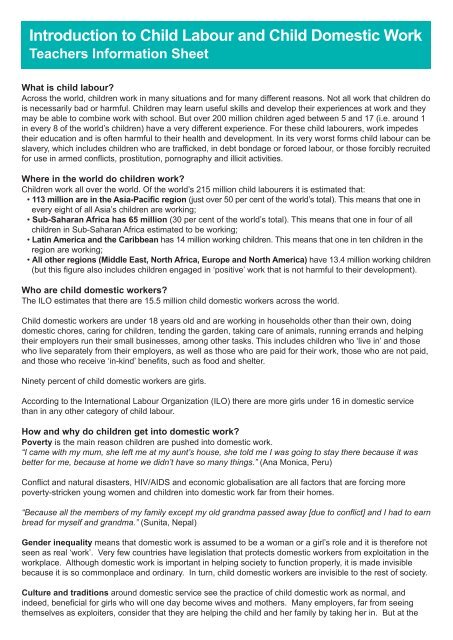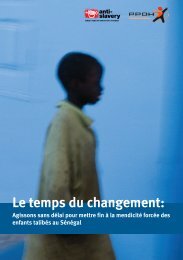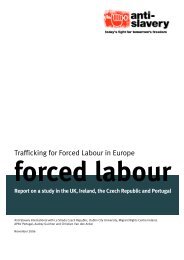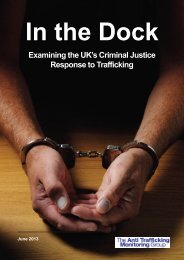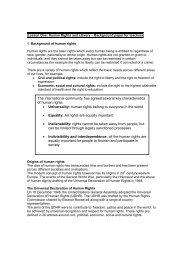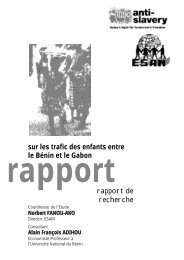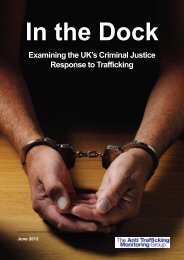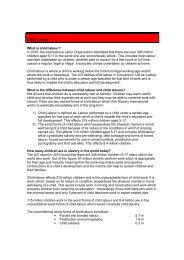Introduction to Child Labour and Child Domestic Work
Teacher Info Sheet - Anti-Slavery International
Teacher Info Sheet - Anti-Slavery International
- No tags were found...
Create successful ePaper yourself
Turn your PDF publications into a flip-book with our unique Google optimized e-Paper software.
<strong>Introduction</strong> <strong>to</strong> <strong>Child</strong> <strong>Labour</strong> <strong>and</strong> <strong>Child</strong> <strong>Domestic</strong> <strong>Work</strong>Teachers Information SheetWhat is child labour?Across the world, children work in many situations <strong>and</strong> for many different reasons. Not all work that children dois necessarily bad or harmful. <strong>Child</strong>ren may learn useful skills <strong>and</strong> develop their experiences at work <strong>and</strong> theymay be able <strong>to</strong> combine work with school. But over 200 million children aged between 5 <strong>and</strong> 17 (i.e. around 1in every 8 of the world’s children) have a very different experience. For these child labourers, work impedestheir education <strong>and</strong> is often harmful <strong>to</strong> their health <strong>and</strong> development. In its very worst forms child labour can beslavery, which includes children who are trafficked, in debt bondage or forced labour, or those forcibly recruitedfor use in armed conflicts, prostitution, pornography <strong>and</strong> illicit activities.Where in the world do children work?<strong>Child</strong>ren work all over the world. Of the world’s 215 million child labourers it is estimated that:• 113 million are in the Asia-Pacific region (just over 50 per cent of the world’s <strong>to</strong>tal). This means that one inevery eight of all Asia’s children are working;• Sub-Saharan Africa has 65 million (30 per cent of the world’s <strong>to</strong>tal). This means that one in four of allchildren in Sub-Saharan Africa estimated <strong>to</strong> be working;• Latin America <strong>and</strong> the Caribbean has 14 million working children. This means that one in ten children in theregion are working;• All other regions (Middle East, North Africa, Europe <strong>and</strong> North America) have 13.4 million working children(but this figure also includes children engaged in ‘positive’ work that is not harmful <strong>to</strong> their development).Who are child domestic workers?The ILO estimates that there are 15.5 million child domestic workers across the world.<strong>Child</strong> domestic workers are under 18 years old <strong>and</strong> are working in households other than their own, doingdomestic chores, caring for children, tending the garden, taking care of animals, running err<strong>and</strong>s <strong>and</strong> helpingtheir employers run their small businesses, among other tasks. This includes children who ‘live in’ <strong>and</strong> thosewho live separately from their employers, as well as those who are paid for their work, those who are not paid,<strong>and</strong> those who receive ‘in-kind’ benefits, such as food <strong>and</strong> shelter.Ninety percent of child domestic workers are girls.According <strong>to</strong> the International <strong>Labour</strong> Organization (ILO) there are more girls under 16 in domestic servicethan in any other category of child labour.How <strong>and</strong> why do children get in<strong>to</strong> domestic work?Poverty is the main reason children are pushed in<strong>to</strong> domestic work.“I came with my mum, she left me at my aunt’s house, she <strong>to</strong>ld me I was going <strong>to</strong> stay there because it wasbetter for me, because at home we didn’t have so many things.” (Ana Monica, Peru)Conflict <strong>and</strong> natural disasters, HIV/AIDS <strong>and</strong> economic globalisation are all fac<strong>to</strong>rs that are forcing morepoverty-stricken young women <strong>and</strong> children in<strong>to</strong> domestic work far from their homes.“Because all the members of my family except my old gr<strong>and</strong>ma passed away [due <strong>to</strong> conflict] <strong>and</strong> I had <strong>to</strong> earnbread for myself <strong>and</strong> gr<strong>and</strong>ma.” (Sunita, Nepal)Gender inequality means that domestic work is assumed <strong>to</strong> be a woman or a girl’s role <strong>and</strong> it is therefore notseen as real ‘work’. Very few countries have legislation that protects domestic workers from exploitation in theworkplace. Although domestic work is important in helping society <strong>to</strong> function properly, it is made invisiblebecause it is so commonplace <strong>and</strong> ordinary. In turn, child domestic workers are invisible <strong>to</strong> the rest of society.Culture <strong>and</strong> traditions around domestic service see the practice of child domestic work as normal, <strong>and</strong>indeed, beneficial for girls who will one day become wives <strong>and</strong> mothers. Many employers, far from seeingthemselves as exploiters, consider that they are helping the child <strong>and</strong> her family by taking her in. But at the
“I did not like my employer because she would shout at me, call me a ‘Tai’ [shit] <strong>and</strong> ‘Anjing’ [dog]. Why am Ibeing treated this way? I could not st<strong>and</strong> my employer’s treatment of me.” (Evi, Indonesia)No access <strong>to</strong> schoolingAlthough child domestic workers generally place a lot of importance on their schooling, their work presents aserious obstacle <strong>to</strong> studying. Commonly, this is simply because employers do not allow them <strong>to</strong> go <strong>to</strong> school –or break initial promises <strong>to</strong> do so.The employers promised me so much…. they <strong>to</strong>ld my parents they will send me <strong>to</strong> school. But did not. I feltvery lonely. (Shanta, India)Even when child domestic workers are given the opportunity <strong>to</strong> go <strong>to</strong> school, the long working hours <strong>and</strong>requirements of their job often make it impossible <strong>to</strong> take up a school place or they end up dropping out asthey have little time for homework <strong>and</strong> are <strong>to</strong>o tired <strong>to</strong> study properly. Because of these problems they arediscouraged from returning <strong>to</strong> formal education because of the need <strong>to</strong> earn money for their families.“Even if my employer encouraged me <strong>to</strong> go <strong>to</strong> school, I decided not <strong>to</strong> enrol because I wanted <strong>to</strong> save moneythat I can send back <strong>to</strong> my family.” (Grace, the Philippines)Hazardous work<strong>Child</strong> domestic workers are exposed <strong>to</strong> a variety of household dangers. Hazardous household chemicals (suchas cleaning fluids), kitchen knives, irons, boiling water <strong>and</strong> the use of unfamiliar household appliances havecaused many child domestic workers serious injuries <strong>and</strong> even death – especially amongst younger children<strong>and</strong> those already exhausted from a full day’s work. There are also likely <strong>to</strong> be long term health impacts ofchronic sleep deprivation, <strong>and</strong> being ‘on-call’ 24 hours a day, as well as effects resulting from heavy tasks suchas water collecting.“The basement was full of water, where we had <strong>to</strong> sleep, so we slept on the same wet floor. We had heardthere will be a leakage of electricity on the wet floor so we were frightened <strong>to</strong> sleep. We kept on mopping thefloor in order <strong>to</strong> be able <strong>to</strong> sleep. The owner came at 4am when we were mopping the floor <strong>and</strong> said ‘maketea for me’.” (Priya <strong>and</strong> Shruti, India)What protection exists for child domestic workers?ILO Minimum Age Convention 138 – this legislation sets out the minimum age that children are allowed <strong>to</strong> startwork (under certain conditions). In most countries this is 14 or 15 years old. In some countries domestic workis specifically excluded.ILO Worst Form of <strong>Child</strong> <strong>Labour</strong> Convention 182 – this convention focuses on the types of child labour thatshould be abolished as a priority. While child domestic work is not specifically abolished in this convention assuch, certain working conditions that many child domestic workers face are considered harmful i.e. workingthrough the night, or work where children are under the control of their employers.The ILO has recently adopted a new international convention <strong>to</strong> protect domestic workers - Convention 189 on<strong>Domestic</strong> <strong>Work</strong>. Although the focus of the convention is on adult domestic workers, the convention highlightsthe central role of education in the protection of child domestic workers from exploitation <strong>and</strong> recommendsspecial measures for child domestic workers <strong>to</strong> protect them from abuse <strong>and</strong> exploitation.‘A new law would give us strength <strong>to</strong> report abuse’ (Jennifer, Philippines)‘I want that, by the help of God, we domestic workers may become independent <strong>and</strong> successful. May ourcurrent suffering s<strong>to</strong>p, may it not be forever’. (Frederick, Togo)Please see the Powerpoint presentation of pho<strong>to</strong>graphs of child domestic workers.For more information on child domestic workers see <strong>Child</strong>ren Unite’s website:www.childrenunite.org.uk/child-domestic-work/


